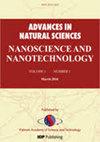A method for alleviating the effect of pinhole defects from silicon nitride film in n-type rear-junction PERT silicon solar cells
IF 2.1
Q3 MATERIALS SCIENCE, MULTIDISCIPLINARY
Advances in Natural Sciences: Nanoscience and Nanotechnology
Pub Date : 2023-05-16
DOI:10.1088/2043-6262/acd241
引用次数: 0
Abstract
We investigated incorporation of a novel approach of phosphorous silicate glass layer thinning (PGT) process in the N-PERT process flow to minimise pinhole defects at the silicon nitride (Si3N4) surface. The thinning (PGT) process for optimum HF deposition time of 12 min resulted in excellent cell efficiency of ∼20.55% with pinhole free layer and high electrical yield (∼0% for I Rev > 1.5 A). After optimising technology, stability is also explored with and without PGT process line, which confirms advantages of this approach. This significant reverse failure reduction due to the proposed PGT process can eventually help in improving overall cell performance of the N-PERT devices. This process can be a part of strategy for reducing process cost of solar cell in any industrial mass production line with improved yield (reduction in reverse failure from 6.6 to 1.5% for one month of mass production). Thus, the PGT process with negligible electrical rejection and high yield increases the possibility of high throughput in mass production line.一种减轻n型后结PERT硅太阳能电池中氮化硅薄膜针孔缺陷影响的方法
我们研究了在N-PERT工艺流程中结合磷硅酸盐玻璃层减薄(PGT)工艺的新方法,以最大限度地减少氮化硅(Si3N4)表面的针孔缺陷。最佳HF沉积时间为12分钟的减薄(PGT)工艺产生了无针孔层的优良电池效率~ 20.55%和高电产率(I Rev > 1.5 A)。优化技术后,还探索了使用和不使用PGT工艺线的稳定性,证实了该方法的优势。由于所提出的PGT工艺,这种显著的反向故障减少最终有助于提高N-PERT器件的整体电池性能。该工艺可作为降低任何工业量产线太阳能电池工艺成本的策略的一部分,提高产量(在一个月的量产中,将逆向失败率从6.6降低到1.5%)。因此,PGT工艺具有可忽略的电排斥和高成品率,增加了大批量生产线的高吞吐量的可能性。
本文章由计算机程序翻译,如有差异,请以英文原文为准。
求助全文
约1分钟内获得全文
求助全文
来源期刊

Advances in Natural Sciences: Nanoscience and Nanotechnology
NANOSCIENCE & NANOTECHNOLOGYMATERIALS SCIE-MATERIALS SCIENCE, MULTIDISCIPLINARY
自引率
4.80%
发文量
0
 求助内容:
求助内容: 应助结果提醒方式:
应助结果提醒方式:


